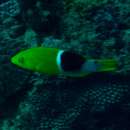pt-BR
nomes no trilho de navegação


Bodianus atrolumbus, the pale-bar hogfish, is a species of wrasse from the genus Bodianus.[2][3] The fish lives in the Western Indian Pacific between the Mascarene Islands and the coast of Southeast Africa. It's a tropical reef inhabitant that feeds on invertebrates like sea urchins and crabs. It grows to a length of 30 centimetres. The fish looks similar to his family member Bodianus perditio but has more yellow or golden colours. Both species have the typical white line with the large black spot behind it.
Bodianus atrolumbus, the pale-bar hogfish, is a species of wrasse from the genus Bodianus. The fish lives in the Western Indian Pacific between the Mascarene Islands and the coast of Southeast Africa. It's a tropical reef inhabitant that feeds on invertebrates like sea urchins and crabs. It grows to a length of 30 centimetres. The fish looks similar to his family member Bodianus perditio but has more yellow or golden colours. Both species have the typical white line with the large black spot behind it.
Bodianus atrolumbus (Valenciennes, 1839) è un pesce osseo marino appartenente alla famiglia Labridae diffuso nell'oceano Indiano occidentale.[1]
Il suo areale si estende dal KwaZulu-Natal in Sudafrica al Mozambico e comprende le Isole Mascarene;[2] la località tipo è Mauritius.[3] Vive nelle barriere coralline e su fondali rocciosi.[2]
Il corpo, compresso sui lati e allungato, ha una lunghezza massima registrata di 30,7 cm[2]. La pinna caudale ha il margine dritto nei giovani, mentre negli adulti è allungata alle estremità. La pinna dorsale e la pinna anale sono basse e lunghe e presentano rispettivamente 12 e 3 raggi spiniformi.[3]
Gli esemplari giovani hanno una colorazione giallastra con un'ampia area nera nella seconda metà del corpo, preceduta da una fascia verticale bianco-rosata e seguita da una fascia dello stesso colore sul peduncolo caudale. L'area nera tende a ridursi fino diventare una macchia sbiadita sul dorso dei maschi adulti. Da giovane è quasi indistinguibile da Bodianus perditio, specie con cui è stato posto in sinonimia dal 1949 fino al 2013; con la crescita la fascia verticale chiara sui fianchi del pesce non tende però ad accorciarsi e ritirarsi al di sopra della linea laterale, rimanendo invece verticale.[2]
Si nutre di invertebrati bentonici di cui distrugge il guscio con i denti faringei: le prede più comuni sono ricci di mare, gasteropodi e granchi.[2]
Bodianus atrolumbus (Valenciennes, 1839) è un pesce osseo marino appartenente alla famiglia Labridae diffuso nell'oceano Indiano occidentale.